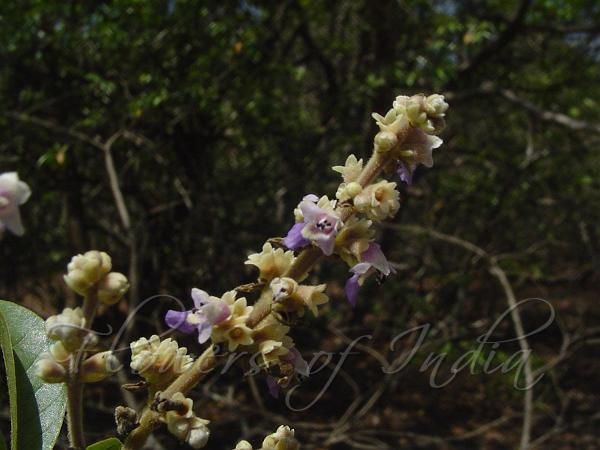|
| Peacock Chaste Tree |
|

|

| File size | 277119 |
| Original date | 5/5/08 11:10 AM |
| Resolution | 2048 x 1360 |
| Flash | Flash did not fire |
| Focal length | 6.3mm |
| Exposure time | 1/320s |
| Aperture | 8.0 |
| Focus Distance | |
| Metering Mode | Spot |
| Camera make | SONY |
| Camera model | DSC-P52 |
| Sensor type |
|
|
|
|
Photo: |
Botanical name: Vitex altissima Family: Verbenaceae (Verbena family)
Peacock Chaste Tree is a large tree growing up to 40 meters in height, with quadrangular and channelled branchlets. Leaves are compound, palmate, 3-5 foliate, winged rachis, leaflets are elliptic or elliptic-oblong, acute at both the ends. Back of the leaves is white-woolly.
Flowers are whitish, tinged with blue, borne in hairy panicles at the end
of branches. Fruits ovoid drupes, containing hard seed. Peacock Chaste Tree
produces berries abundantly during September-December. Within India, it is
found in Assam and Meghalaya, and the Deccan Peninsula, up to an altitude
of 1200 m in the hills. Flowering: April-May.
Medicinal uses: In Ayurvedic medicine, the plant is believed to
pacify vitiated kapha, vata, inflammation, wounds, ulcers, allergy, eczema,
pruritus, worm infestations, urinary system diseases, stomatitis,
emaciation, and ailments after parturition. Useful part are leaves and
roots.
In Ayurvedic medicine, the plant is believed to
pacify vitiated kapha, vata, inflammation, wounds, ulcers, allergy, eczema,
pruritus, worm infestations, urinary system diseases, stomatitis,
emaciation, and ailments after parturition. Useful part are leaves and
roots.
Medicinal uses:
 In Ayurvedic medicine, the plant is believed to
pacify vitiated kapha, vata, inflammation, wounds, ulcers, allergy, eczema,
pruritus, worm infestations, urinary system diseases, stomatitis,
emaciation, and ailments after parturition. Useful part are leaves and
roots.
In Ayurvedic medicine, the plant is believed to
pacify vitiated kapha, vata, inflammation, wounds, ulcers, allergy, eczema,
pruritus, worm infestations, urinary system diseases, stomatitis,
emaciation, and ailments after parturition. Useful part are leaves and
roots. | Identification credit: Prashant Awale | Photographed in Phansad Wild Life Sanctuary, Maharashtra. |
• Is this flower misidentified? If yes,